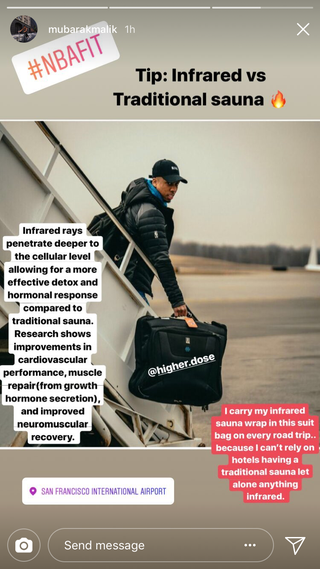
Bar Malik, the director of performance for the New York Knicks, spends the better part of eight months a year on the road, traveling between 75 and 80 days total. During those travel days, he collectively spends around 150 hours on a plane, and another 50 on a bus.
So how does he manage to do it all without ever taking a sick day? Malik says it’s thanks to his far-infrared sauna wrap. It’s a six-foot, 15-pound wrap made of ceramic and carbon panels that you plug into the wall, set to your preferred level and temperature, and then lie inside of for usually about an hour.
Malik brings it with him every time he travels, lying in it before bed in his hotel rooms. “My coworkers and staff know that when we’re on the road and we arrive at a new city, that first day, I work out, have a shake, and then lie in my sauna wrap around 10:00 before bed for an hour,” he says. “It puts me in a relaxed state to fall asleep.”

Bar Malik/Instagram
Far-infrared saunas use far-infrared radiation (FIR) to emit infrared light waves, which create heat. The effect is akin to your body being heated by the rays of the sun. The technology has been used in spas for years, especially in places like Europe and Japan, and a few small studies have shown that it can increase blood circulation and reduce fatigue and soreness.
But it’s only been until the last few years or so that far-infrared tech has popped up in saunas and studios around the United States — and even more recently that sauna wraps and suits have come onto the scene. Recovery studios like ReCOVER, which just opened in New York City, have FIR saunas available for anyone to use, and the Athlete Performance and Innovation team at Under Armour has an infrared sauna in its facility.
Getting your body ready for summer? Our infrared saunas help you achieve your fitness goals—faster. ⚡️Because harmful toxins hold your body back from performing its best, proper detoxing is integral to your get-fit plan. ⠀ ⠀
A post shared by HigherDOSE (@higher.dose) on
“A lot of studies are now starting to explore the benefits of infrared saunas,” says Michael Watts, senior manager at the Under Armour Athlete Performance and Innovation Team. The brand even teamed up with Tom Brady to create athlete recovery sleepwear, which printed far-infrared technology on the inside of pajamas to help promote recovery while sleeping.
“You still don’t see too many teams having far infrared saunas in their facilities, but I predict it will be more common,” says Watts. In the never-ending debate over whether hot vs. cold is best for recovery, FIR saunas have an obvious competitive edge: given the choice between an ice bath or a sauna, which would you choose?
“Recovery is always about compliance and getting athletes to do something that will help them,” says Watts. “If it’s something they enjoy doing or feel the benefit from, chances are they’ll want to do it more.”
While the New York Knicks do not have a FIR sauna at their training facility, Malik encourages his players to use it during their off days. He claims that FIR tech doesn’t just boost their recovery, but also their performance.
Like most other health and wellness crazes, far-infrared technology doesn’t come without its skeptics. The purported benefits are extremely wide-ranging, with people claiming that the wraps can do everything from helping shed your body of “toxins” to clearing up your skin to helping you lose weight. But there really isn’t any research to back most of these claims up.
Plus, at an average cost of $45 for a 30-minute studio sauna session or $700 for a wrap, FIR tech is extremely pricey. Malik says the benefits are worth it, and that “sauna suits are for a person who doesn’t mind spending a little bit of income on their health,” but given how little hard evidence there is to support the benefits, that’s quite a bit of an investment.
Here’s what we do know. “Infrared technology increases respiratory rate, heart rate, internal body temperature, and metabolism…temporarily,” says Taz Bhatia, MD, board-certified integrative medicine physician and wellness expert in Atlanta, GA. “Some of the other touted benefits include help with detoxification, chronic fatigue, and pain. [But] the research is debated and the results vary from person to person.”
Joseph M. Ojile, MD, FCCP, founder, CEO and medical director of the Clayton Sleep Institute in St. Louis, MO, agrees. “It’s an interesting idea and application of technology, [but] we don’t have absolute sureness on whether it could work or not,” he says. Still, he sees the technology as promising, in that it frames recovery as just as significant to overall wellness as diet and exercise. “As doctors, we want to encourage our patients to be active and exercise and to view recovery as a part of their exercise program. A product like this starts to link recovery as a part of the total health plan, [along with] diet and exercise.”
So can everyday gym goers or weekend warriors truly benefit from FIR technology? It depends how rigorous your fitness routine is.
“In terms of recovery, warming the muscles always helps with improving circulation to muscles and joints, which facilitates healing,” says Bhatia. “I think sauna suits and such have a place for cold weather athletes, for muscle recovery, and injury prevention. For an athlete looking for options to recover from extreme sports or prepping for competition, it would be worth it; for the weekend warrior, an epsom salt bath or soak may be a good first step.”
Source: Read Full Article